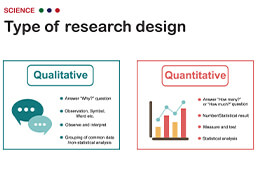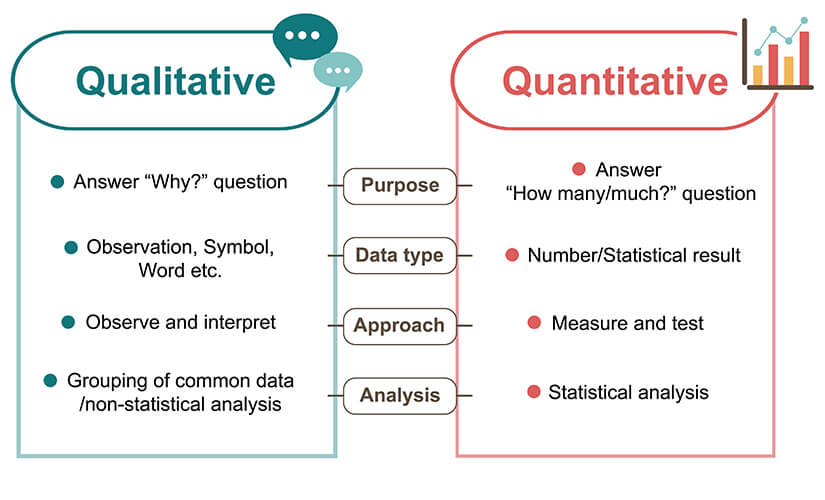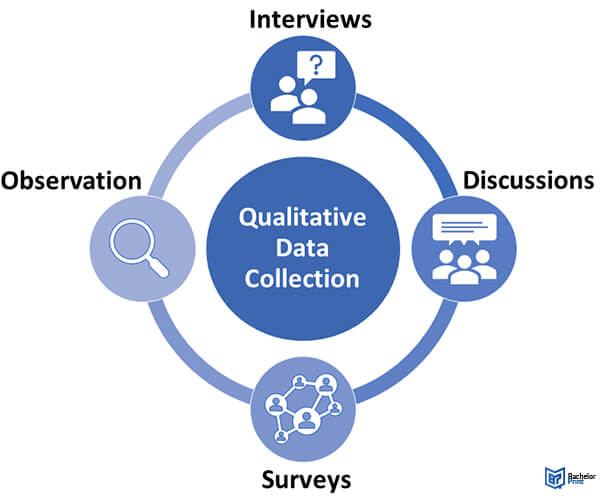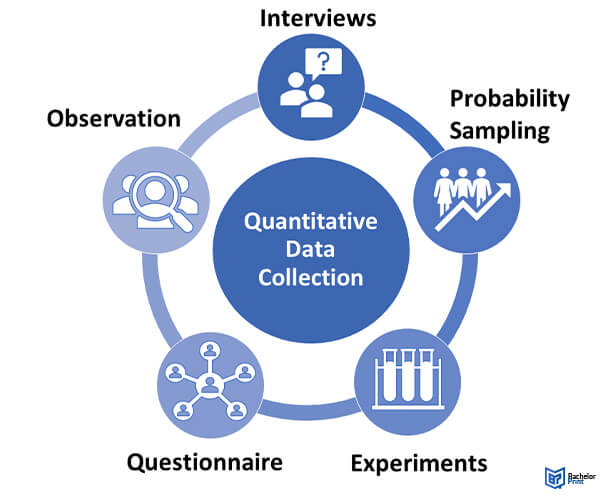
Qualitative vs. quantitative research are two of the most common types of research. Although both research methods analyze data, they differ in their methodologies and the type of data they analyze. While qualitative research focuses on exploring in-depth insights and understanding of phenomena through methods like interviews and observations, quantitative research quantifies data and applies statistical analysis, offering empirical evidence and generalizable results.
Definition: Qualitative vs. Quantitative research
What are the differences between qualitative vs. quantitative research?
- Qualitative research refers to the analysis of text data.
- Quantitative research deals with units or numbers.
Other characteristics of quantitative vs. qualitative research include:
Qualitative research:
- focuses on words, concepts, descriptions, and ideas.
- studies topics with a small body of knowledge.
- gathers facts through interviews, questionnaires, and existing literature.
Quantitative research:
- is concerned with numbers.
- measures quantifiable units, analyzed with graphs and other data visualization techniques.
- studies assumptions using measurable units, unlike qualitative research, which studies non-numerical concepts and ideas.
What is the difference? – Qualitative vs. Quantitative research
The main differences between qualitative vs. quantitative research are based on their approaches and methodologies:
| Research Approach | Methodologies |
| Qualitative Research | • Expressed in numbers, graphs, models • Data is collected through interviews, observations • Answers the question “why?” by evaluating and compiling responses • Assumes a dynamic pool of responses |
| Quantitative Research | • Expressed in statements and ideas • Data is collected through surveys, experiments • Answers the question “what?’ by creating statistical patterns • Assumes a fixed set of variables |

When is it relevant to use Qualitative vs. Quantitative research?
The data type usually determines which research method will be the most effective. For your study, choose:
- Quantitative analysis when you’re working around a hypothesis or a test topic.
- Qualitative research to study an idea or experience
In some cases, a mixed approach of both qualitative vs. quantitative research is applied. This is common in broad studies with numerical and text-based data inputs.
The following outlines the main distinctions of the qualitative vs. quantitative research approach.
Qualitative research approach
You can hand out open-ended questionnaires to 20 staff at a company. Some questions you can ask may be as follows:
- How often do you get a raise or a promotion?
- What is the relationship between management and other staff?
- Do you recommend your company to other job seekers?
Quantitative research approach
You can approach the same research question using quantitative research. For instance, you can formulate a series of close-ended questions. Examples of preset responses may include:
- Yes or no responses
- A rating system – for instance, between 1 -9, how would you rate the work/life balance?
- You can input the responses into an analytical software like Excel, which will reveal outcomes in numerical data.
Mixed methods approach
Quantitative research can collect fixed yes or no responses. You can then ask open-ended questions to get further insight into the yes or no response using qualitative methods.
The mixed method uses quantitative research to identify that 70% of workers are happy. Qualitative research shows why they are happy.
Data Collection Methods in Qualitative vs. Quantitative Research
With quantitative vs. qualitative research methods, data may be collected and analyzed respectively in order to create such insights.
Qualitative research studies concepts and ideas. Here, researchers use data inputs such as images, text, and videos, whereas quantitative data is collected from numerical data sets.
Examples of qualitative vs. quantitative research methods:
| Qualitative Data | Quantitative Data |
| • Open-ended interviews • Case studies • Focus groups and discussions |
• Surveys • Sample probabilities • Secondary quantitative sources |
Data Analysis in Qualitative vs. Quantitative Research
Qualitative vs. quantitative research analysis uses distinct data types and sources.
Qualitative Research Analysis
Qualitative research analysis may be carried out in the following ways:
- Content analysis – This refers to the study of recorded information. This approach intends to find commonalities and supporting evidence for research topics.
- Thematic analysis – Qualitative methods result in collecting large amounts of data. This data can be analyzed by uncovering themes in the data, such as similarities and causality.
- Grounded Theory – This analysis method uses qualitative data to construct theories for research studies.


Quantitative Research Analysis
Quantitative data is numerical; it can be analyzed using mathematical models. Some methods of analysis include:
- Means – This refers to average occurrences in a data set. For instance, “most people marry at 31.”
- Causation and correlation – For instance, 20% of workers create 70% of the total output
- Medians – Mid-points in a data set, for example, the median age in this set – 9, 14, 16, 17, 19 is 16.
Benefits and Limitations in Qualitative vs. Quantitative Research
Qualitative vs. quantitative research approaches are both systematic to a subject of study. Both qualitative vs. quantitative research methods have their benefits and limitations defined in the below:
| Research method | Benefits | Limitations |
|
Quantitative Research |
• It is suitable for undertaking extensive surveys • Offers in-depth conclusions and findings • You can collect information faster with quantitative research • It is a scientific-based approach that follows generally accepted standards |
• There are limited conclusions from the study • It often requires complex formulas and models • The findings may become obsolete with time • It may be expensive in some cases |
| Qualitative Research | • It can be used to study several phenomena at the same time • It offers a large sample size for analysis • It can be done on an ongoing process – some studies are conducted for years using qualitative methods • It is not limited by numerical sources of data |
• It does not provide statistical information which may be essential in some cases • It is a rigorous process that may not be defined clearly • A lot of unusable data may be collected • It is a time-consuming process for projects that may have deadlines. |
FAQs
Quantitative research studies numerical data. Qualitative analysis is used when the data is not represented in numbers, such as the impacts of poverty on health.
A mixed approach uses quantitative and qualitative data sources as part of a comprehensive study. It utilizes different sources of data and analyses to make informed assumptions.
Quantitative analysis is better suited for statistical studies. Qualitative research is more applicable to abstract and immeasurable concepts.
